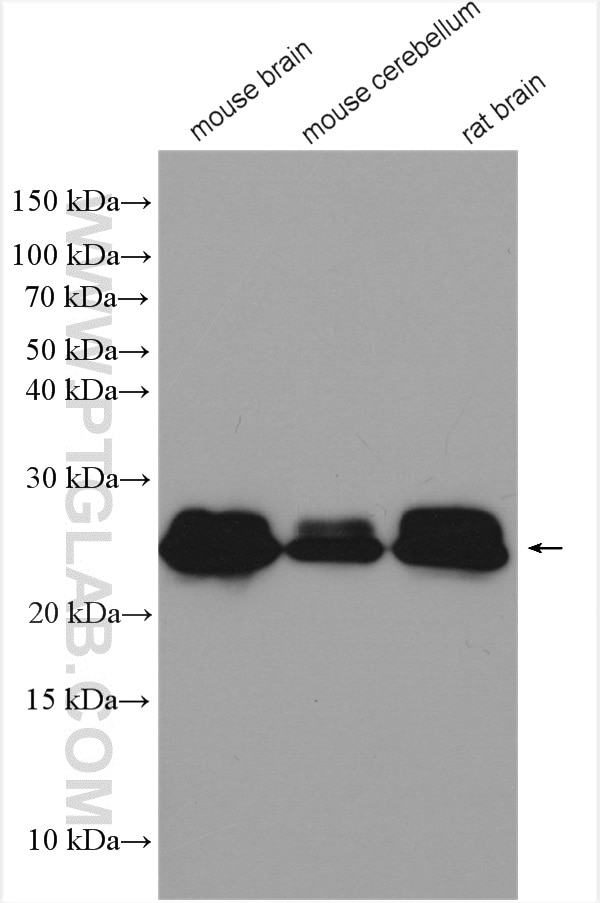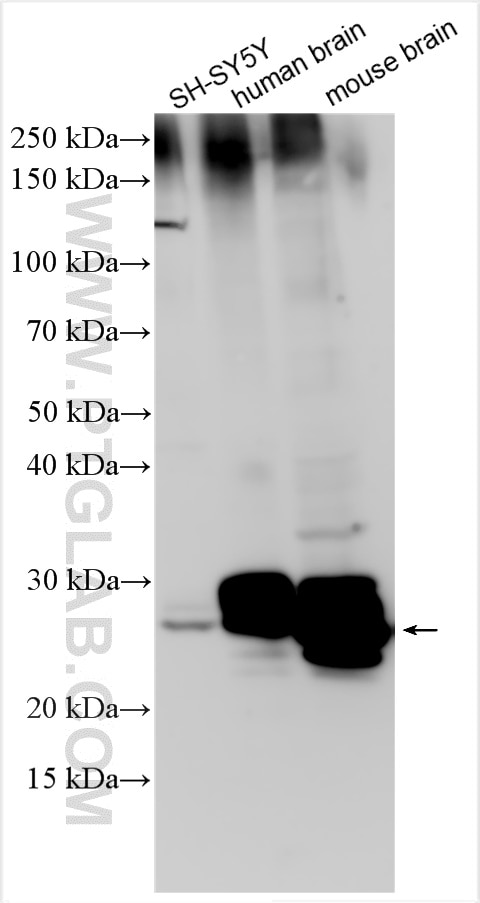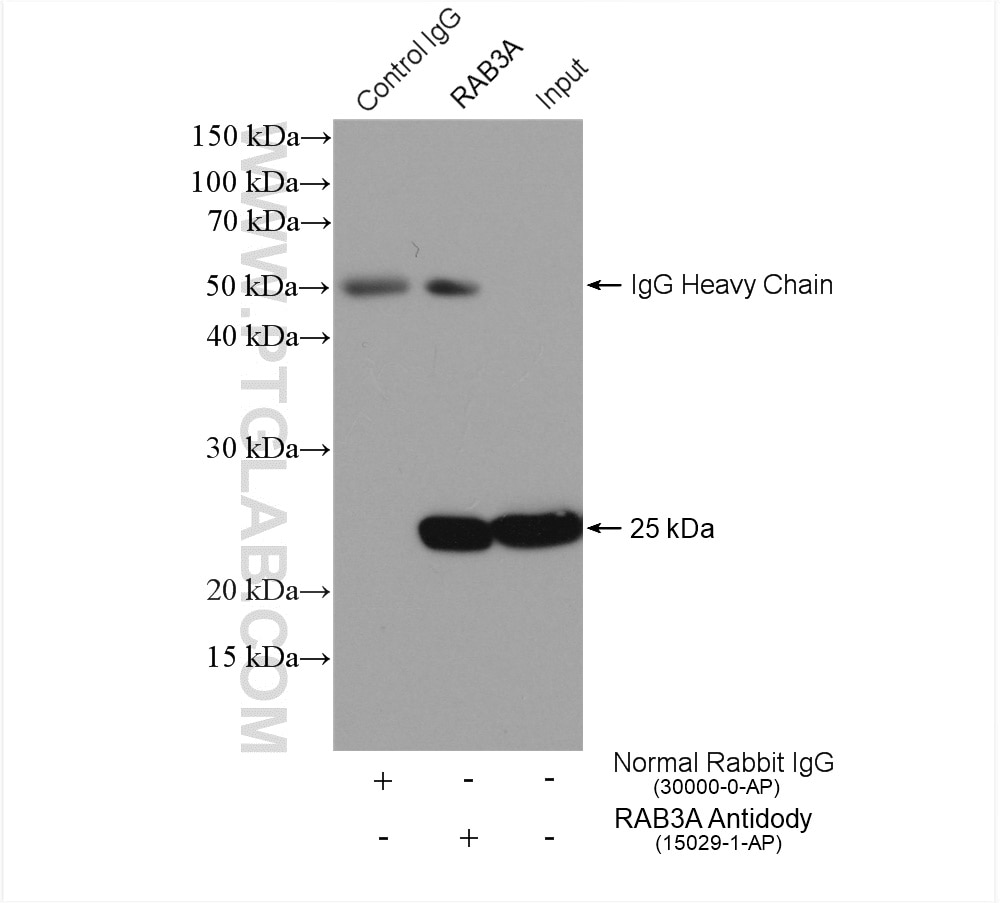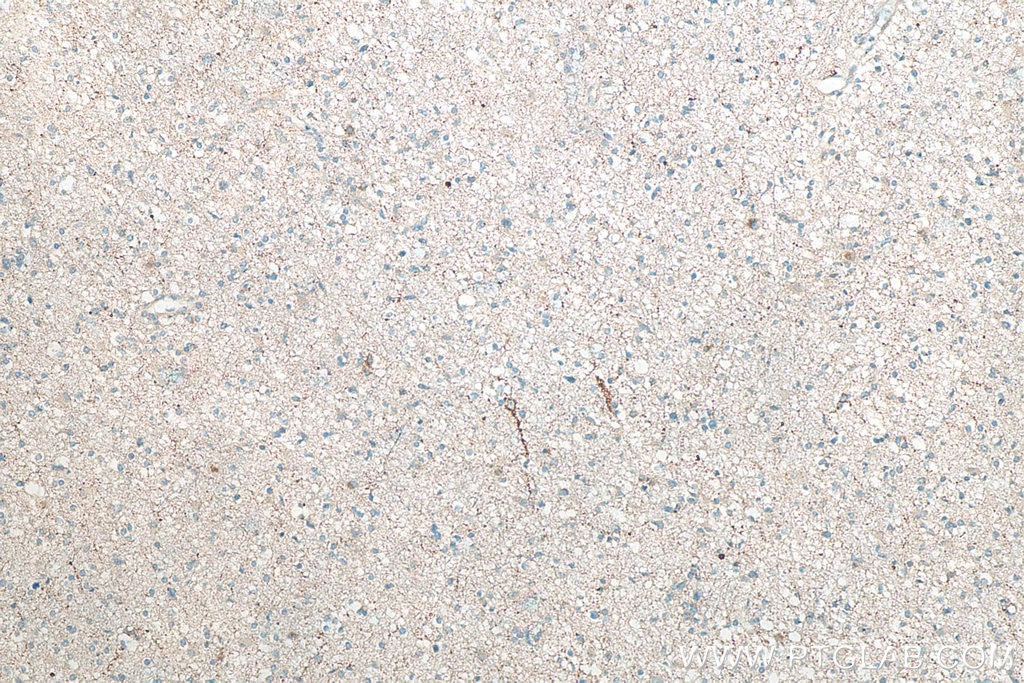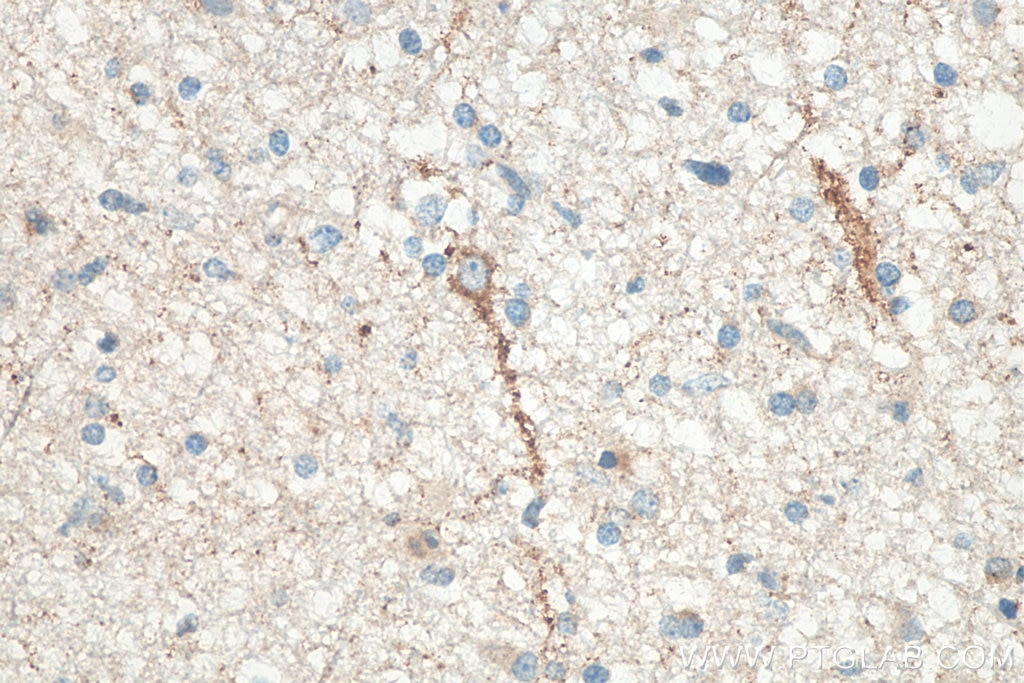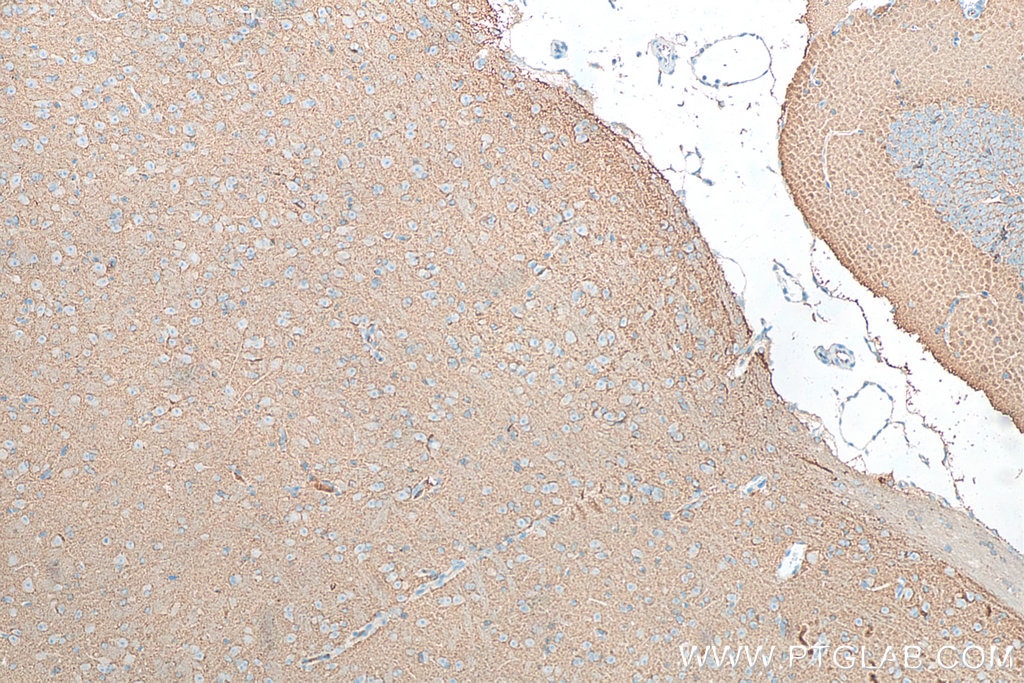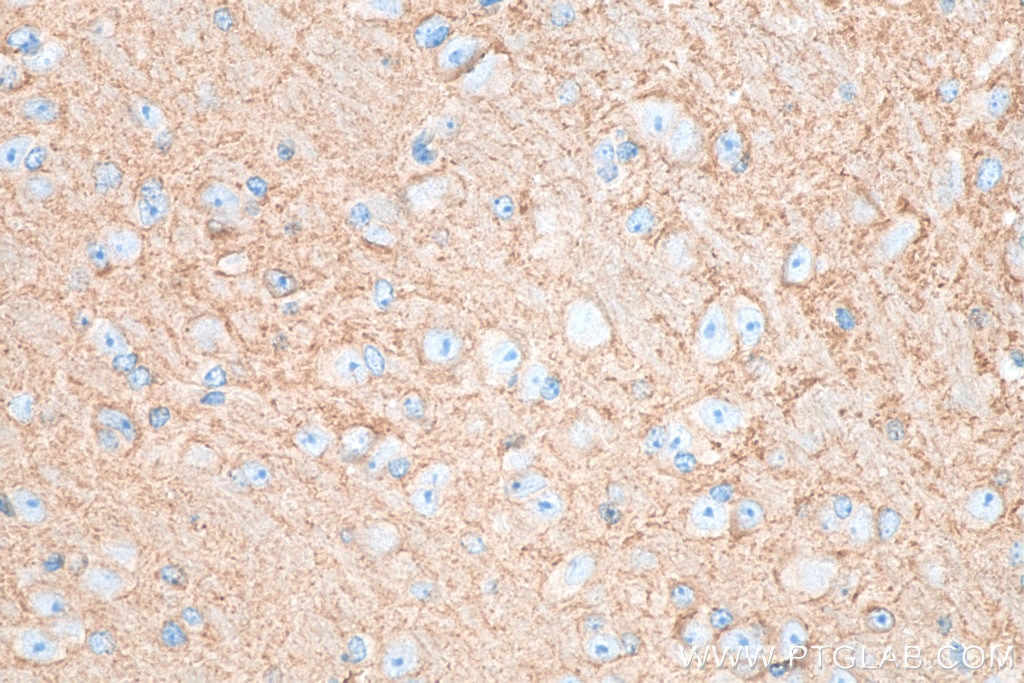- Featured Product
- KD/KO Validated
RAB3A Polyklonaler Antikörper
RAB3A Polyklonal Antikörper für IHC, IP, WB, ELISA
Wirt / Isotyp
Kaninchen / IgG
Getestete Reaktivität
human, Maus, Ratte
Anwendung
WB, IP, IHC, IF, ELISA
Konjugation
Unkonjugiert
Kat-Nr. : 15029-1-AP
Synonyme
Galerie der Validierungsdaten
Geprüfte Anwendungen
| Erfolgreiche Detektion in WB | Maushirngewebe, humanes Hirngewebe, Maus-Cerebellum-Gewebe, Rattenhirngewebe, SH-SY5Y-Zellen |
| Erfolgreiche IP | Maushirngewebe |
| Erfolgreiche Detektion in IHC | humanes Gliomgewebe, Maushirngewebe Hinweis: Antigendemaskierung mit TE-Puffer pH 9,0 empfohlen. (*) Wahlweise kann die Antigendemaskierung auch mit Citratpuffer pH 6,0 erfolgen. |
Empfohlene Verdünnung
| Anwendung | Verdünnung |
|---|---|
| Western Blot (WB) | WB : 1:1000-1:6000 |
| Immunpräzipitation (IP) | IP : 0.5-4.0 ug for 1.0-3.0 mg of total protein lysate |
| Immunhistochemie (IHC) | IHC : 1:50-1:500 |
| It is recommended that this reagent should be titrated in each testing system to obtain optimal results. | |
| Sample-dependent, check data in validation data gallery | |
Veröffentlichte Anwendungen
| KD/KO | See 1 publications below |
| WB | See 7 publications below |
| IHC | See 3 publications below |
| IF | See 2 publications below |
Produktinformation
15029-1-AP bindet in WB, IP, IHC, IF, ELISA RAB3A und zeigt Reaktivität mit human, Maus, Ratten
| Getestete Reaktivität | human, Maus, Ratte |
| In Publikationen genannte Reaktivität | human, Maus |
| Wirt / Isotyp | Kaninchen / IgG |
| Klonalität | Polyklonal |
| Typ | Antikörper |
| Immunogen | RAB3A fusion protein Ag1903 |
| Vollständiger Name | RAB3A, member RAS oncogene family |
| Berechnetes Molekulargewicht | 25 kDa |
| Beobachtetes Molekulargewicht | 25 kDa |
| GenBank-Zugangsnummer | BC011782 |
| Gene symbol | RAB3A |
| Gene ID (NCBI) | 5864 |
| Konjugation | Unkonjugiert |
| Form | Liquid |
| Reinigungsmethode | Antigen-Affinitätsreinigung |
| Lagerungspuffer | PBS mit 0.02% Natriumazid und 50% Glycerin pH 7.3. |
| Lagerungsbedingungen | Bei -20°C lagern. Nach dem Versand ein Jahr lang stabil Aliquotieren ist bei -20oC Lagerung nicht notwendig. 20ul Größen enthalten 0,1% BSA. |
Hintergrundinformationen
Rab3A is a small G-protein of the Rab family, that is implicated in vesicle fusion and regulated secretion, particularly in neurotransmitter release. Rab3 subfamily small G proteins (Rab3A, Rab3B, Rab3C, and Rab3D) control the regulated exocytosis in neuronal/secretory cells. Rab3A is the most abundant Rab GTPase in brain, where it is associated with synaptic vesicles. Rab3A is believed to modulate secretion efficiency by stimulating vesicle recruitment to sites of exocytosis and/ or by recruiting regulatory molecules to the docking/ fusion machinery.
Protokolle
| Produktspezifische Protokolle | |
|---|---|
| WB protocol for RAB3A antibody 15029-1-AP | Protokoll herunterladen |
| IHC protocol for RAB3A antibody 15029-1-AP | Protokoll herunterladen |
| IP protocol for RAB3A antibody 15029-1-AP | Protokoll herunterladen |
| Standard-Protokolle | |
|---|---|
| Klicken Sie hier, um unsere Standardprotokolle anzuzeigen |
Publikationen
| Species | Application | Title |
|---|---|---|
Mol Oncol Overexpression of synaptic vesicle protein Rab GTPase 3C promotes vesicular exocytosis and drug resistance in colorectal cancer cells | ||
Mol Cancer Secretory RAB GTPase 3C modulates IL6-STAT3 pathway to promote colon cancer metastasis and is associated with poor prognosis. | ||
Cell Death Dis O-GlcNAcylation on Rab3A attenuates its effects on mitochondrial oxidative phosphorylation and metastasis in hepatocellular carcinoma.
| ||
FASEB J Role of RanBP9 on amyloidogenic processing of APP and synaptic protein levels in the mouse brain. | ||
PLoS One RanBP9 Overexpression Accelerates Loss of Pre and Postsynaptic Proteins in the APΔE9 Transgenic Mouse Brain. | ||
Biochem Pharmacol Zoledronate modulates intracellular vesicle trafficking in mast cells via disturbing the interaction of myosinVa/Rab3a and sytaxin4/VAMP7. |
